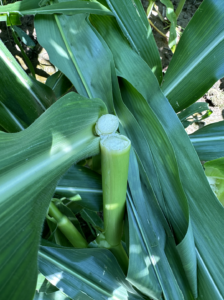You’ve all heard the saying “knee-high by the fourth of July” to describe the progress of a corn crop. It’s a phrase many folks still refer to today. But as the photo below shows, that saying is now laughable. In fact, if you’re a Midwest farmer and your corn is now knee high, it’s probably in big trouble. So where did the adage come from? It likely started before hybrid seed corn was invented, when planting dates occurred in late May/early June and when mature corn plants were much shorter. With the advent of hybrid seed corn, and adoption of synthetic nitrogen, there was a meteoric rise in yields and corn growth. My corn was planted on May 4th, and on July 4th it was tasseled and twice as high as my son’s girlfriend!
“Corn as high as an elephant’s eye” – which more accurately describes corn such as mine on the Fourth of July – is a phrase taken from the popular musical Oklahoma! It’s used to describe how tall corn is at maturity, which can be 9-12 feet tall. While tall appearance may seem like a desirable trait in corn, that’s not always the case. In fact, the taller the corn, the more potential problems. Tall corn is more susceptible to damage from high winds, often referred to as straight-line winds, which are brought about from summer thunderstorms that result in powerful, hurricane-force wind gusts. Such winds can blow the plants down. While the plants often rise back up somewhat, they can become tangled throughout the field. This not only impacts yield; it can make harvesting extremely difficult. Take it from one who’s done it, combining down corn is no fun! You often have to drive the combine one way in order to pick up the plants, operate at much slower speeds and may need to attach a reel to the corn head to pick up and flow the stalks through the machine. Last week, high winds leveled crops in many areas of Illinois. For the corn in this photo, yields will be reduced and harvesting will be a nightmare.
High winds can also cause green snap in corn, which literally snaps the stalks in two. This usually occurs during the peak growth periods, just prior to tasseling. As stalk nodes grow rapidly, cell walls are not yet matured; the node tissue is packed with water and little lignin tissue has been deposited in the stalks, making them fragile and vulnerable to wind. Genetics can play a role in a hybrid’s susceptibility to green snap. In many cases, racehorse hybrids – those bred for rapid growth and the highest yield potential – are more vulnerable to environmental issues such as green snap. If the stalks are snapped above the ear shoot, ears can be formed, yet some yield loss is inevitable. But if stalks snap below the ear shoots, the plant will not produce a harvestable ear. It was long believed that for every 1% of plants impacted by green snap, a 1% yield loss occurs. But new studies from Iowa State suggest that yield loss ranges from 0.5-0.73 per 1% of plants impacted. This speaks to today’s genetics, and corn plants’ ability to compensate for the loss of neighboring plants by producing larger, heavier ears.
Farmers who purchase federal crop insurance – used on 90% of all commodity acres – can receive protection against wind damage, provided the damage is widespread and the extent of the damage warrants a claim. An added layer of protection is a Crop Hail insurance policy, which also covers wind damage. These policies can be applied on an acre-by-acre basis.
Related Posts

Wastewater Wednesday: Swansea in Massachusetts Uses Federal Funding for Sewer Expansion

The Impact of Commonly Abused and Illicit Drugs in Wastewater Treatment
By Heather Jennings, PE, Senior Project Engineer for Probiotic Solutions® I was attending a wastewater conference and overheard an operator talking about how a drug bust turned his lagoon orange and almost put him out of compliance with his permit. At another location, I was told that the city I was visiting had been hit by...

Humic Acid Biostimulant Research by BHN Humic R&D Lab Scientists Published in Int’l Agronomic Journal
In its May 2021 issue, Frontiers in Plant Science published a research article by BHN Humic R&D Lab scientists Dr. Hiarhi Monda, Ryan Fountain, and Dr. Richard T. Lamar in collaboration with Dr. Amy McKenna of the National High Magnetic Field Laboratory, Ion Cyclotron Resonance Facility, Tallahassee, Fla. The research, titled “Bioactivity of Humic Acids...



